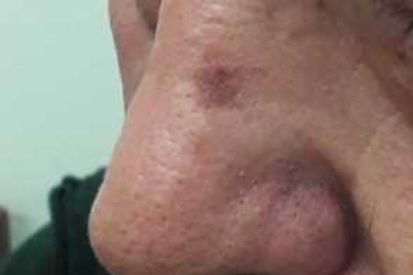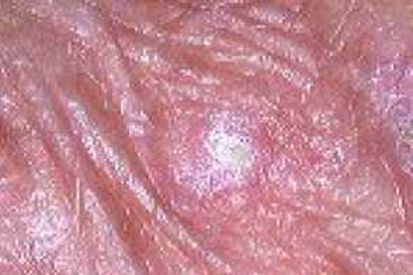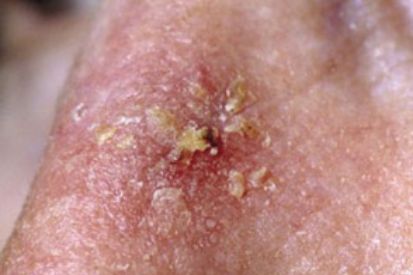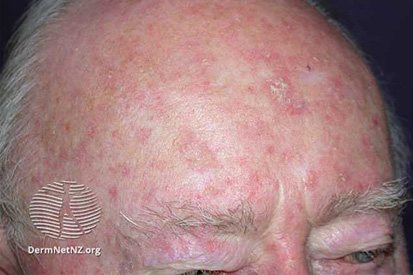Actinic Keratosis
Individuals with fair skin, light-colored hair, blue or green eyes, or those who have had significant sun exposure over their life are at greater risk of developing actinic keratosis. Outdoor enthusiasts are also more susceptible, and this condition is most commonly observed in those aged forty and older.
Actinic Keratosis is a precancerous skin condition that requires attention from a dermatologist. Regular visits to a Pinehurst Dermatology & Mohs Surgery Center provider can help manage and prevent the progression of actinic keratosis into more serious skin issues.
Examples Actinic Keratosis




What are the Symptoms of Actinic Keratosis?
- Actinic Keratosis can reach a quarter of an inch in size and may even disappear for a time.
- May appear red, light or dark tan, pink or skin-colored.
- These patches may be sensitive or tender and may become inflamed or even bleed.
- Although the patches are typically dry they may also present as lesions that do not heal or as thick, horny growths.
Causes of Actinic Keratosis
- Actinic keratosis (AK) is primarily caused by prolonged exposure to ultraviolet (UV) radiation from the sun or artificial sources like tanning beds.
- The cumulative effect of sun damage leads to the development of these precancerous lesions.
- The risk of actinic keratosis increases with age, reflecting the cumulative impact of sun exposure over the years.
- Individuals with weakened immune systems may be at a higher risk of developing actinic keratosis.
How to Prevent Actinic Keratosis
- Sunscreen: Regularly apply a broad-spectrum sunscreen with a high SPF to exposed skin, even on cloudy days. Reapply every two hours and more frequently if sweating or swimming.
- Protective Clothing: Wear protective clothing, such as wide-brimmed hats, long sleeves, and sunglasses, to shield the skin from direct sunlight. Clothing with a tight weave offers additional protection.
- Seek Shade: Limit direct sun exposure during peak hours, typically between 10 a.m. and 4 p.m. When outdoors, seek shade under trees, umbrellas, or other structures.
- Avoid Tanning Beds: Refrain from using tanning beds, as they emit harmful UV radiation that contributes to skin damage.
- Regular Skin Examinations: Perform at-home self-examinations of the skin regularly to detect any changes or new lesions as well as schedule annual total body skin exams with your trusted dermatology provider. Notify your provider of any suspicious growths or changes you find.
- Limit Alcohol and Tobacco: Excessive alcohol consumption and smoking can contribute to skin damage, so moderation or cessation of these habits is beneficial.
- Stay Hydrated: Proper hydration helps maintain skin health. Drink an adequate amount of water to support overall skin function.
Actinic Keratosis FAQs
Actinic Keratosis lesions generally do not hurt, and many individuals might not feel any pain. However, some may experience tenderness, itching, or a burning sensation in the affected spots. If you notice any changes in your skin, such as discomfort or new lesions, it's essential to consult a Pinehurst Dermatology provider for an assessment.
Dermatologists treat actinic keratosis using methods like cryotherapy, topical medications, photodynamic therapy, laser therapy, or chemical peels, depending on the lesion's severity and location. The treatment choice is tailored to each patient, with regular follow-up to monitor for changes or new lesions.
Learn about Actinic Keratosis with Jennifer Whaley, NP
How to Treat Actinic Keratosis
Treatment options may include:
- Cryotherapy: The use of liquid nitrogen to freeze the lesions superficially
- Topical Creams: Designed to eliminate Actinic Keratosis in the affected areas.
Featured Products for Sun Protection

OfeliaMarie MD Skincare PROTECT
PROTECT Broad Spectrum SPF 30 with antioxidants. Designed to lightly hydrate your delicate skin while providing protection from the sun. Developed for the face and the body. It is recommended to use this light crème be used at the end of every treatment and the beginning of every day.

ZO® Gel Sunscreen Broad-Spectrum SPF 50
A clear and unscented gel sunscreen with a complexion-smoothing finish for all skin tones. Exclusive antioxidant + plant stem cell complexes minimize the aging effects of environmental aggressors. Water and sweat resistant up to 40 minutes. Fragrance-free. 45 g / 1.6 Oz.
